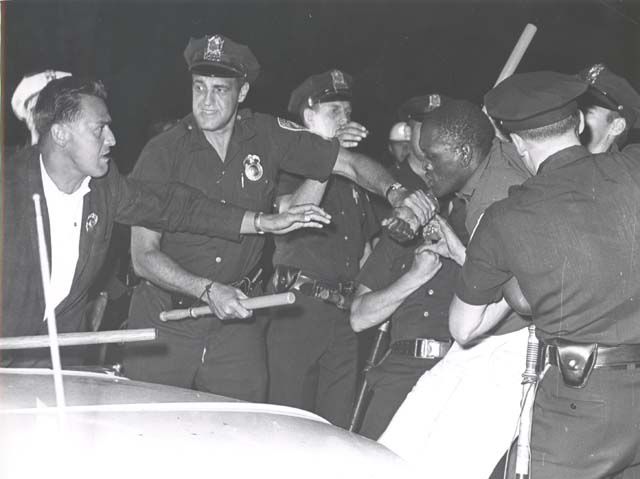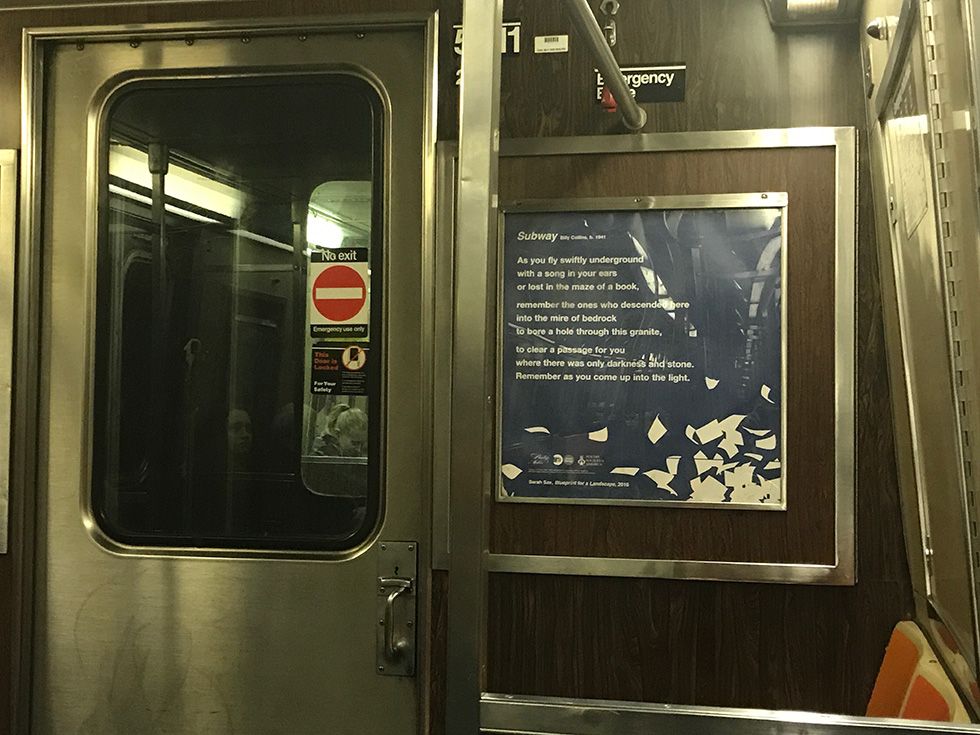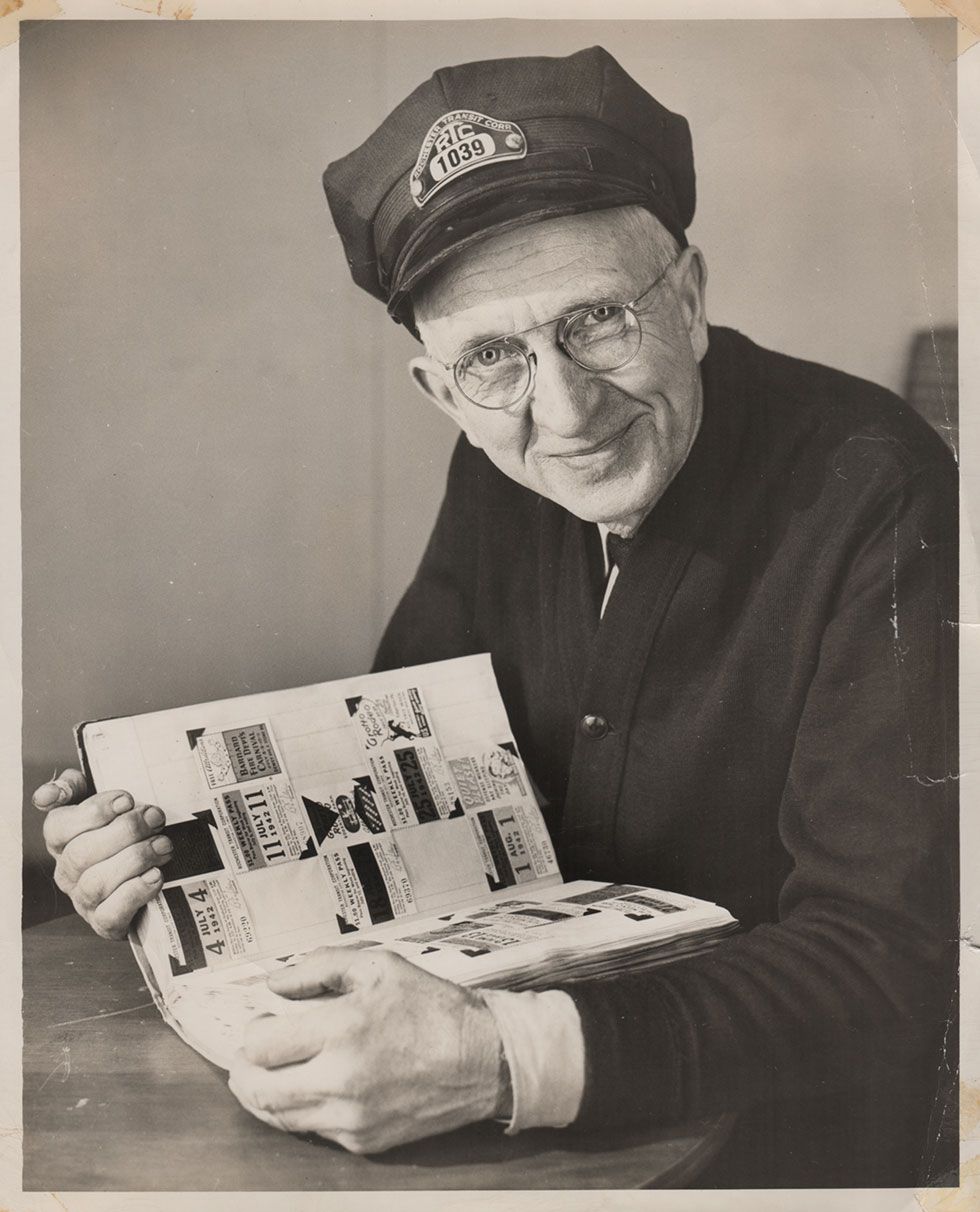This article was scraped from Rochester Subway. This is a blog about Rochester history and urbanism has not been published since 2017. The current owners are now publishing link spam which made me want to preserve this history.. The original article was published July 24, 2014 and can be found here.
![Scene from the Rochester riots, July 24-26, 1964. [PHOTO: Rochester Municipal Archives]](https://senseofplace.dev/content/images/photos/rochester-riots-1964-02.jpg)
On July 24, 1964


took place which led to three of the darkest days in Rochester's history. They had come to Rochester seeking a better life, yet African Americans in Rochester at that time still had to fight for jobs, fight for education, fight for housing... even for the simple right to stand on the sidewalk in their own neighborhood and not be questioned by police. By the 1960s the mistreatment of black people in this country--over the course of centuries--finally reached a boiling point. And Rochester was in the eye of the storm...
![Scene from the Rochester riots, July 24-26, 1964. [PHOTO: Rochester Municipal Archives]](https://senseofplace.dev/content/images/photos/rochester-riots-1964-01.jpg)
The following AP article printed in newspapers across the country on July 27, 1964, attempts to describe the Rochester riots which started on Clarissa Street

and quickly spread to Jefferson Ave

to the west, and Joseph Ave

to the east...
'Some Boy Causing Fuss' First Warning Of Trouble in Rochester Riot Area
ROCHESTER. NY (AP) -- Helen Myricks was pleased with the way things were turning out. There Was $60 collected for the playground from the sale of barbecue sandwiches, hot dogs and punch. Now the last record was spinning and the street dance would end. The people, especially the teenagers, seemed to be enjoying themselves. Then someone came to Gene Stevens, whose wife, Carrie, was one of the dance organizers with Mrs. Myricks, and said, "Some boy over there is causing a fuss." Stevens had been keeping an eye on things. This was just a last minute kind of dance for the people on the block. Friday nights had been too full of hell raising in the Negro section as it was. It was wise to keep an eye open. Stevens told the boy to quiet down. So did some others. He wouldn't. So Stevens went to the Myricks' porch where two white patrolmen, Anthony Cerretto and Roger Bacon were standing. "We walked up to this guy," says Cerretto, "and we didn't even get a chance to ask him to leave. He started yelling and resisting and swinging. The next thing, we were all on the ground. Bacon and me and the guy. We put the cuffs on him. "That this crowd that was dancing and enjoying itself turned on us. They yelled for us to take off the cuffs and let the guy go. They wedged between us. Two plainclothesmen who were at the end of Nassau Street on Joseph Avenue came from their car to help us. They were Dan Funk and Sal Arnone. Then everything let loose. Either Dan or Sal, I don't know which, got back and radioed for help." It was 11:38 p.m. Friday, July 25, 1964, the minute, the hour, the day, the date, the year that thriving, comfortable Rochester learned how a riot is born. But there is no time for history in the birth of a riot. The communication system of a riot is rumor. Rumor moves faster than any electronic device. it jumps rivers and walls and buildings. It has a music: sirens. It has a color: red, for the blood on men's hands. That call for help put through by Funk or Arnone brought cars with sirens and lights. The riot that had just been born mushroomed grotesquely. Rocks and stones and old bricks from a large empty lot on Joseph Avenue near Nassau Street greeted the squads. Men and boys and women and girls jeered and swore at police. Wire trash baskets sailed from the crowd to land on the officers. Several K-9 Corps teams arrived. Police later said the dogs no time were off their leashes and that investigations showed no one was bitten during the rioting. The mob reached a new fury. Broken bottles littered the street and 50 police faced perhaps 500 persons. All of the action was centered at the Intersection of Joseph Avenue and Nassau Street. The riot was 27 minutes old. The looting began. Two hours passed. Time enough for the word to have spread like a typhus. A crowd of whites blossomed between the New York Central station and the U.S. Post Office. On one side of the street were the whites; Negroes on the other. Fire trucks arrived. So did police from Brighton and Greece. The hoses stiffened with the pressure of water and the threat of a race riot was crushed. The dawn brought a scene of senseless, wanton destruction. What end did this serve? This is the question. But a riot needs no end except to be what it is. And Negroes trying to explain it to themselves as well as others came to the same conclusion: that frustration and bitterness are reason for violence. Anyone who tried to impose reason quickly learned this. After two nights, there scarcely was a street in any of the Negro areas that did not show scars of violence. On Sunday afternoon, there came a spectacle so sickening that it was felt that this might sober men and bring sense to them. A helicopter used to observe riot areas hit a Negro dwelling, plunged to the sidewalk, exploded and set the building afire. The pilot was killed and so were two persons in the house. But Sunday night brought no respite. The riot finally did come to its tired end, spent by the energy of its own fury, and the plain fact that there was nothing to win, either at the beginning or the end. - By Bernard Gayzer, Associated Press. July 28, 1964
![Scene from the Rochester riots, July 24-26, 1964. [PHOTO: Rochester Municipal Archives]](https://senseofplace.dev/content/images/photos/rochester-riots-1964-15.jpg)
![Scene from the Rochester riots, July 24-26, 1964. [PHOTO: Rochester Municipal Archives]](https://senseofplace.dev/content/images/photos/rochester-riots-1964-16.jpg)
![Scene from the Rochester riots, July 24-26, 1964. [PHOTO: Rochester Municipal Archives]](https://senseofplace.dev/content/images/photos/rochester-riots-1964-06.jpg)
![Scene from the Rochester riots, July 24-26, 1964. [PHOTO: Rochester Municipal Archives]](https://senseofplace.dev/content/images/photos/rochester-riots-1964-07.jpg)
![Scene from the Rochester riots, July 24-26, 1964. [PHOTO: Rochester Municipal Archives]](https://senseofplace.dev/content/images/photos/rochester-riots-1964-03.jpg)
![Scene from the Rochester riots, July 24-26, 1964. [PHOTO: Rochester Municipal Archives]](https://senseofplace.dev/content/images/photos/rochester-riots-1964-09.jpg)
![Scene from the Rochester riots, July 24-26, 1964. [PHOTO: Rochester Municipal Archives]](https://senseofplace.dev/content/images/photos/rochester-riots-1964-11.jpg)
![Scene from the Rochester riots, July 24-26, 1964. [PHOTO: Rochester Municipal Archives]](https://senseofplace.dev/content/images/photos/rochester-riots-1964-12.jpg)
![Scene from the Rochester riots, July 24-26, 1964. [PHOTO: Rochester Municipal Archives]](https://senseofplace.dev/content/images/photos/rochester-riots-1964-05.jpg)
![Scene from the Rochester riots, July 24-26, 1964. [PHOTO: Rochester Municipal Archives]](https://senseofplace.dev/content/images/photos/rochester-riots-1964-13.jpg)
![Scene from the Rochester riots, July 24-26, 1964. [PHOTO: Rochester Municipal Archives]](https://senseofplace.dev/content/images/photos/rochester-riots-1964-14.jpg)
![Scene from the Rochester riots, July 24-26, 1964. [PHOTO: Rochester Municipal Archives]](https://senseofplace.dev/content/images/photos/rochester-riots-1964-17.jpg)
![Scene from the Rochester riots, July 24-26, 1964. [PHOTO: Rochester Municipal Archives]](https://senseofplace.dev/content/images/photos/rochester-riots-1964-18.jpg)
![Scene from the Rochester riots, July 24-26, 1964. [PHOTO: Rochester Municipal Archives]](https://senseofplace.dev/content/images/photos/rochester-riots-1964-04.jpg)
![Scene from the Rochester riots, July 24-26, 1964. [PHOTO: Rochester Municipal Archives]](https://senseofplace.dev/content/images/photos/rochester-riots-1964-19.jpg)
![Scene from the Rochester riots, July 24-26, 1964. [PHOTO: Rochester Municipal Archives]](https://senseofplace.dev/content/images/photos/rochester-riots-1964-20.jpg)
![Scene from the Rochester riots, July 24-26, 1964. [PHOTO: Rochester Municipal Archives]](https://senseofplace.dev/content/images/photos/rochester-riots-1964-21.jpg)
![Scene from the Rochester riots, July 24-26, 1964. [PHOTO: Rochester Municipal Archives]](https://senseofplace.dev/content/images/photos/rochester-riots-1964-10.jpg)
![Scene from the Rochester riots, July 24-26, 1964. [PHOTO: Rochester Municipal Archives]](https://senseofplace.dev/content/images/photos/rochester-riots-1964-23.jpg)
![Scene from the Rochester riots, July 24-26, 1964. [PHOTO: Rochester Municipal Archives]](https://senseofplace.dev/content/images/photos/rochester-riots-1964-24.jpg)
![Scene from the Rochester riots, July 24-26, 1964. [PHOTO: Rochester Municipal Archives]](https://senseofplace.dev/content/images/photos/rochester-riots-1964-34.jpg)
![Scene from the Rochester riots, July 24-26, 1964. [PHOTO: Rochester Municipal Archives]](https://senseofplace.dev/content/images/photos/rochester-riots-1964-35.jpg)
![Scene from the Rochester riots, July 24-26, 1964. [PHOTO: Rochester Municipal Archives]](https://senseofplace.dev/content/images/photos/rochester-riots-1964-36.jpg)
![Scene from the Rochester riots, July 24-26, 1964. [PHOTO: Rochester Municipal Archives]](https://senseofplace.dev/content/images/photos/rochester-riots-1964-37.jpg)
![Scene from the Rochester riots, July 24-26, 1964. [PHOTO: Rochester Municipal Archives]](https://senseofplace.dev/content/images/photos/rochester-riots-1964-38.jpg)
![Scene from the Rochester riots, July 24-26, 1964. [PHOTO: Rochester Municipal Archives]](https://senseofplace.dev/content/images/photos/rochester-riots-1964-39.jpg)
![Scene from the Rochester riots, July 24-26, 1964. [PHOTO: Rochester Municipal Archives]](https://senseofplace.dev/content/images/photos/rochester-riots-1964-40.jpg)
![Scene from the Rochester riots, July 24-26, 1964. [PHOTO: Rochester Municipal Archives]](https://senseofplace.dev/content/images/photos/rochester-riots-1964-41.jpg)
![Scene from the Rochester riots, July 24-26, 1964. [PHOTO: Rochester Municipal Archives]](https://senseofplace.dev/content/images/photos/rochester-riots-1964-42.jpg)
![Scene from the Rochester riots, July 24-26, 1964. [PHOTO: Rochester Municipal Archives]](https://senseofplace.dev/content/images/photos/rochester-riots-1964-43.jpg)
![Scene from the Rochester riots, July 24-26, 1964. [PHOTO: Rochester Municipal Archives]](https://senseofplace.dev/content/images/photos/rochester-riots-1964-44.jpg)
![Scene from the Rochester riots, July 24-26, 1964. [PHOTO: Rochester Municipal Archives]](https://senseofplace.dev/content/images/photos/rochester-riots-1964-45.jpg)
![Scene from the Rochester riots, July 24-26, 1964. [PHOTO: Rochester Municipal Archives]](https://senseofplace.dev/content/images/photos/rochester-riots-1964-46.jpg)
![Scene from the Rochester riots, July 24-26, 1964. [PHOTO: Rochester Municipal Archives]](https://senseofplace.dev/content/images/photos/rochester-riots-1964-47.jpg)
![Scene from the Rochester riots, July 24-26, 1964. [PHOTO: Rochester Municipal Archives]](https://senseofplace.dev/content/images/photos/rochester-riots-1964-48.jpg)
![Scene from the Rochester riots, July 24-26, 1964. [PHOTO: Rochester Municipal Archives]](https://senseofplace.dev/content/images/photos/rochester-riots-1964-49.jpg)
![Scene from the Rochester riots, July 24-26, 1964. [PHOTO: Rochester Municipal Archives]](https://senseofplace.dev/content/images/photos/rochester-riots-1964-50.jpg)
![Scene from the Rochester riots, July 24-26, 1964. [PHOTO: Rochester Municipal Archives]](https://senseofplace.dev/content/images/photos/rochester-riots-1964-08.jpg)
![Scene from the Rochester riots, July 24-26, 1964. [PHOTO: Rochester Municipal Archives]](https://senseofplace.dev/content/images/photos/rochester-riots-1964-25.jpg)
![Scene from the Rochester riots, July 24-26, 1964. [PHOTO: Rochester Municipal Archives]](https://senseofplace.dev/content/images/photos/rochester-riots-1964-26.jpg)
![Scene from the Rochester riots, July 24-26, 1964. [PHOTO: Rochester Municipal Archives]](https://senseofplace.dev/content/images/photos/rochester-riots-1964-27.jpg)
![Scene from the Rochester riots, July 24-26, 1964. [PHOTO: Rochester Municipal Archives]](https://senseofplace.dev/content/images/photos/rochester-riots-1964-28.jpg)
![Scene from the Rochester riots, July 24-26, 1964. [PHOTO: Rochester Municipal Archives]](https://senseofplace.dev/content/images/photos/rochester-riots-1964-29.jpg)
![Scene from the Rochester riots, July 24-26, 1964. [PHOTO: Rochester Municipal Archives]](https://senseofplace.dev/content/images/photos/rochester-riots-1964-30.jpg)
![Scene from the Rochester riots, July 24-26, 1964. [PHOTO: Rochester Municipal Archives]](https://senseofplace.dev/content/images/photos/rochester-riots-1964-31.jpg)
![Scene from the Rochester riots, July 24-26, 1964. [PHOTO: Rochester Municipal Archives]](https://senseofplace.dev/content/images/photos/rochester-riots-1964-32.jpg)
![Scene from the Rochester riots, July 24-26, 1964. [PHOTO: Rochester Municipal Archives]](https://senseofplace.dev/content/images/photos/rochester-riots-1964-33.jpg)
Fifty years on we're still grappling with what happened, and why it did. In his story, writer Bernard Gayzer says "there is no time for history in the birth of a riot." But I think one thing is certain; if we discount history, we can count on a replay. * * *


